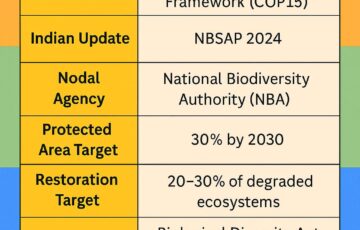Preventive Healthcare: Key Pillar for Healthy, Productive India
Syllabus:
GS-2:
Health , Important International Institutions
GS-3:
Government Policies & Interventions
Focus:
India is witnessing a surge in non-communicable diseases (NCDs), which account for nearly two-thirds of all deaths. This silent epidemic is undermining economic productivity and public health. The focus on curative care must now shift towards preventive healthcare to ensure sustainable development, improved quality of life, and reduced disease burden.
The Urgency of Preventive Healthcare in India:
a. India’s Growth Ambition and the Health Paradox
- India is aiming to become a $5 trillion economy and a global leader.
- A “silent epidemic” of Non-Communicable Diseases (NCDs) threatens this progress.
- NCDs are the leading cause of death, responsible for about two-thirds of all deaths in India.
- Focus must shift from curative to preventive healthcare — to “heal before there is a need to heal.”
b. Shift in Disease Burden
- India has experienced an epidemiological transition — from communicable to non-communicable diseases.
- Diseases like heart disease, diabetes, stroke, cancer, and chronic lung illnesses now dominate.
- NCDs are affecting the working-age population, especially those in their 30s and 40s.
- 22% of Indians over 30 are at risk of premature death from NCDs before 70.
c. Economic Ramifications
- NCDs cause significant productivity loss and reduce workforce participation.
- Estimated to cost 5%-10% of India’s GDP.
- A WEF-Harvard study estimated a $3.5–4 trillion loss (2012–2030) due to NCDs.
- Preventive healthcare is an economic investment, not a liability.
Understanding Preventive Healthcare in India:● Definition: Preventive healthcare focuses on avoiding disease occurrence, early diagnosis, and managing complications. Types of Preventive Care: ● Primary Prevention: Vaccination, lifestyle changes, hygiene, and health education. ● Secondary Prevention: Early detection through screenings (BP, sugar, mammograms, etc.). ● Tertiary Prevention: Managing chronic diseases to reduce severity and complications. Need for Preventive Healthcare in India: ● NCD Burden: Account for 65% of deaths; hit working-age population early. ● Economic Impact: WHO estimates NCDs could cost ₹280 lakh crore by 2030. ● Healthcare Burden: Early detection reduces hospital admissions and treatment costs. ● Productivity Loss: Chronic illness reduces workforce participation and output. Key Government Initiatives: ● Ayushman Bharat (HWCs & PM-JAY): Promotes early screening and provides ₹5 lakh cover. ● NPCDCS, NTCP, RBSK, Mission Indradhanush: Focus on NCDs, tobacco, child health, immunization. ● PM-ABHIM: Strengthens health infra with ₹64,180 crore outlay. ● Free Drugs & Diagnostics, PMBJP, AMRIT: Reduce out-of-pocket expenditure. Why It Matters ? ● Rising elderly population, malnutrition, high CVD prevalence, and TB cases demand preventive focus. ● Preventive care ensures healthier citizens, lower health costs, and sustained economic growth. |
Lifestyle and Environmental Risk Factors:
a. Modifiable Lifestyle Causes
- Around 80% of premature NCDs can be prevented with lifestyle modifications.
- Risk factors include sedentary lifestyle, poor diet, tobacco/alcohol use, and chronic stress.
- Obesity is rising: 22%-23% of adults are overweight.
b. Call for Healthy Habits
- At least 30 minutes of physical activity daily (e.g., walking, yoga, sports).
- Emphasis on a balanced diet: rich in fruits, vegetables, proteins and low in sugar, salt, unhealthy fats.
- Importance of mental health, hydration, and sleep hygiene.
c. Air Pollution – An Overlooked Threat
- Air pollution worsens COPD, lung cancer, and heart attacks.
- Pollution control must be integrated into public health policy and preventive medicine.
d. Importance of Early Detection
- Screening from age 40, or earlier with family history.
- Common screenings:
- Blood pressure & cholesterol (heart disease)
- Blood sugar (diabetes)
- Mammogram (breast cancer)
- HPV test or Pap smear (cervical cancer)
- Early detection = timely intervention, reducing mortality and healthcare costs.
Technology as a Game-Changer in Preventive Health:
a. Role of Digital Health Tools
- 750+ million smartphone users enable mobile health (mHealth)
- Health apps deliver reminders, assessments, diet plans, and alerts.
- Wearables track fitness, vitals, and sleep, promoting self-monitoring.
b. Predictive Power of Artificial Intelligence (AI)
- AI provides “health risk scores” using personal health data and predictive analytics.
- Can forecast disease risk (e.g., diabetes or cardiac issues) with high accuracy.
- Machine learning detects early signs (e.g., lung nodules, fatty liver) in X-rays/CT scans.
c. Balancing Technology with Compassion
- AI must be used responsibly, ensuring a patient-centric and humane
- Technology should enhance, not replace, human care.
Institutional and Policy Interventions for a Preventive Culture:
a. Making Prevention a National Mindset
- Preventive care is a mindset, not just a medical service.
- Individuals should take charge of health:
- Schedule regular check-ups
- Use stairs over elevators
- Cut sugar/salt, manage screen time
- Prioritise wellness over convenience
b. Role of Corporates
- Workplaces can boost health through:
- Annual screenings
- In-house counsellors
- Fitness/yoga sessions
- Mental health support
c. Role of Healthcare Providers
- Shift from reactive (treatment) to proactive (prevention)
- Hospitals should promote preventive screenings, awareness drives, and teleconsultation.
d. Government Initiatives and Recommendations
- Key government steps:
- National Programme for Prevention and Control of NCDs (NP-NCD)
- Health and Wellness Centres under Ayushman Bharat
- National Programme for Prevention and Control of NCDs (NP-NCD)
- Policy Recommendations:
- Urban planning must enable walkability, parks, cycle lanes
- School education should include nutrition & fitness modules
- Food regulations to reduce salt, sugar, trans fats
- Urban planning must enable walkability, parks, cycle lanes
The Road Ahead: Towards a Health-First India
a. Scaling Individual Action to National Outcomes
- Small daily choices can transform national health when adopted by 4 billion Indians.
- g., 10,000 steps a day, nutritious breakfast, regular sleep schedule.
b. Real-life Impact of Early Prevention
- Thousands of lives saved via early detection of hypertension, cancer, diabetes.
- Prevention reduces hospitalisation costs, preserves productivity, and ensures longevity.
c. Aligning Health with Economic Goals
- A healthier population = stronger economy.
- Preventive healthcare ensures that India’s youth remain productive and innovative.
Conclusion:
India’s rise as an economic superpower depends on the health of its people. The growing threat of NCDs demands a shift to prevention-focused policies. Through early screenings, technology, lifestyle awareness, and inter-sectoral partnerships, India can ensure its people live longer, healthier, and more productive lives.
Source: TH
Mains Practice Question :
Preventive healthcare is not a cost but a long-term investment for a productive nation.” Discuss the importance of preventive medicine in tackling the burden of non-communicable diseases in India. Suggest strategies to build a prevention-first healthcare ecosystem.





